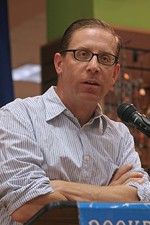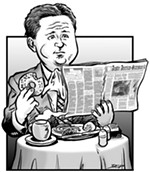Deep Six
Fri., Jan. 5, 1996
in Austin and National Media 1. Bad News. Think TV news is sophomoric in Austin? You're right. Think it's better elsewhere? You're wrong. A Denver-based group called the Rocky Mountain Media Watch analyzed tapes of 100 different broadcasts from 58 cities on the night of September 20. Their findings? The average half hour program contains about 12 minutes of so-called news, about 40% of which is devoted to violent crime and disasters. As they say, if it bleeds, it leads.
2. Total Freedom. The current issue of EXTRA! details the decline of the Freedom Forum Media Studies Center, a think-tank funded by former Gannett Corporation CEO Al Neuharth. About the only thinking this group does now is to justify the corporate mentality of today's mainstream media culture. As smugly noted by Freedom Forum director Everette Dennis, the current spate of media takeovers "challenge the deeply held American notion that big-ness is bad and diversity is good." Very challenging indeed.
3. Sensationalism Sells. 1995 was the year ostensibly respectable publications like The New York Times and The Washington Post felt compelled to publish the Unabomber manifesto. Don't look for any higher standards in 1996. It turns out that newsstand sales of the Post's Una-bomber issue were 16,000 above the daily norm.
4. Tabloid Nation. Who was the hottest editor in America in 1995? That would be David Perel of the National Enquirer, according to an article in the December issue of Details. Perel moved to the forefront by supervising the tabloid's aggressive coverage of the O.J. Simpson trial. As a result, he's been the feature speaker at a meeting of the American Society of Magazine Editors, offered a job at Nightline, and profiled by The New York Times and the Columbia Journalism Review, among others. Go figure.
5. The White Pages. A recent study of the real estate sections of 30 of the nation's largest dailies reveals that -- surprise -- almost all of the faces pictured in the housing ads are white. One of the worst offenders was The Los Angeles Times, in which minorities were absent from all but one of the 37 sampled ads. According to the Fair Housing Act, these spots should reflect roughly the same racial mix as the communities in which they appear.
6. Computer Math. If you're not quite convinced that the on-line revolution is everything it's cracked up to be, you aren't the only one. The veracity of a recent Nielsen survey reporting over 24 million active Internet users has been challenged by Vanderbilt business professor Donna L. Hoffman. Hoffman contends the Nielsen figures are based on flawed methodology and that fewer than 10 million regularly surf the information superhighway. -- Hugh Forrest
Got something to say on the subject? Send a letter to the editor.








